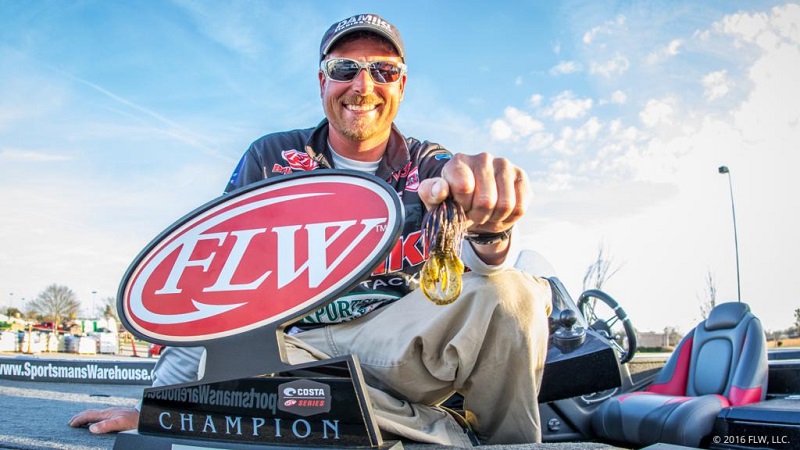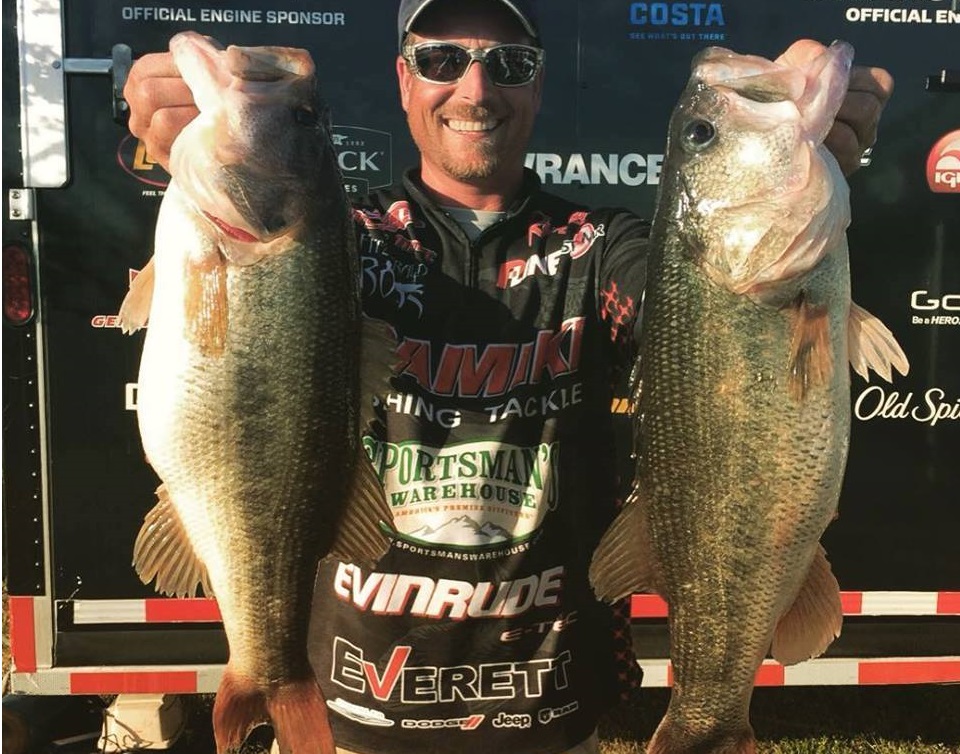 Photo: FLW Outdoors
Photo: FLW Outdoors
There is nothing like making a long skip under a dock and pulling out a big bass. FLW Tour pro Bryan Thrift is widely recognized as one of the best at skipping baits deep under docks and other overhanging cover. Thrift shares some advice to make you a better skipper.
#1 Rod Length and Action For Skipping Baits
The most important piece of your skipping arsenal is the rod you use. Having the right length and action greatly affect how easily you can skip and how far you can get your bait. Thrift designed a rod for Fitzgerald Rods specifically for skipping – a 6’9”, heavy-action rod.
“The 6’9” length is perfect,” said the North Carolina pro. “The whole key with skipping a bait is to generate bait speed when you make a skip. It’s also much easier to be accurate with a shorter rod.”
Another important piece is the rod tip. “I like a softer tip to load up when you begin to make a skip,” he said. “It will make the bait go much further.” Even with a light tip, the heavy action of his signature series rod has the backbone he needs for bigger fish.
 #2 Reel Settings For the Best Skip
#2 Reel Settings For the Best Skip
Thrift isn’t too picky when it comes to reel selection for skipping, but does find a higher speed 7.1:1 reel to be a good choice for the technique. His magnetic brake adjustment settings are much looser than someone who may just be beginning, but it is something to increase over time.
“A good rule of thumb is to adjust your reel so when you drop your bait over the side of the boat, it falls and hits the water and doesn’t backlash,” he added. “That is a good place to start and you can loosen or tighten the brakes based on your experience.”
#3 Line Size and Bait = Fall Rate
You can skip just about any bait and Thrift said he has tried to skip just about everything. His favorite bait to skip is a jig, but he also uses a variety of soft plastics, buzzbaits and frogs.
“When I am skipping docks with a jig, I’ll use a 3/8- or ½-oz most of the time and will either spool it up with 15- or 20-lb P-Line Ultimate Fluorocarbon,” he said. “The line is very, very strong and abrasion resistance and also comes off of the spool easy to get more distance.”
He will adjust his jig weight, line size and plastic trailer based on how fast he wants it to fall. “That is what I do most to change my presentation,” he said. “I’ll switch sizes of jigs and line size and use a different size trailer. For instance if I want it to fall slowly, I’ll use 20-lb line, a 3/8-oz jig and bulky trailer like the Damiki Knockout.”
Soft plastics are another solid choice for skipping. “The Damiki Stinger is a great one and I’ll use both the four and five-inch” size depending on where I’m fishing,” he said. “I’ll skip it using 8-lb P-Line Fluorocarbon all the way up to 15-lb.”
Another of his favorite skipping baits is the Damiki Air Frog, which he says skips very well regardless of your experience, because of its flat design. “When the topwater bite is on, that is a great choice to skip way under docks,” he said. “I’ll skip that with 50- or 65-lb P-Line TCB braid.”
#4 Boat Positioning for the Right Angle
Another key to successful skipping is boat positioning. Getting the right angle is crucial, as is the distance from a dock. “I like to keep my boat way back, around 30-feet back,” said Thrift. “This allows you to really load up and make a long skip and also keeps you from the fish. Stealth is key with skipping.”
#5 Practice, Practice and More Practice
Like everything with bass fishing, the more experience you have with something, the better you will do with it. Thrift recalls when he began to skip docks and how he would force himself to do it all day long.
“I would go out and have three rods on my deck and they would all be baits for skipping,” he said. “I didn’t bring any other rods with me and just did it over and over,”
He also added some advice and reassurance to someone new to the technique. “Even when you have been doing it as long as I have, I still get bad backlashes sometimes and always have extra spools of P-Line on the boat in case I need to re-spool,” he laughed.
Skipping baits deep under cover is a high-risk, high-reward type of fishing and there are many factors like boat wakes, wind and other things that can ruin a cast. The key is to have the right tools for the job and the mechanics down to get a bait way back underneath overhanging cover.


 Advertising
Advertising